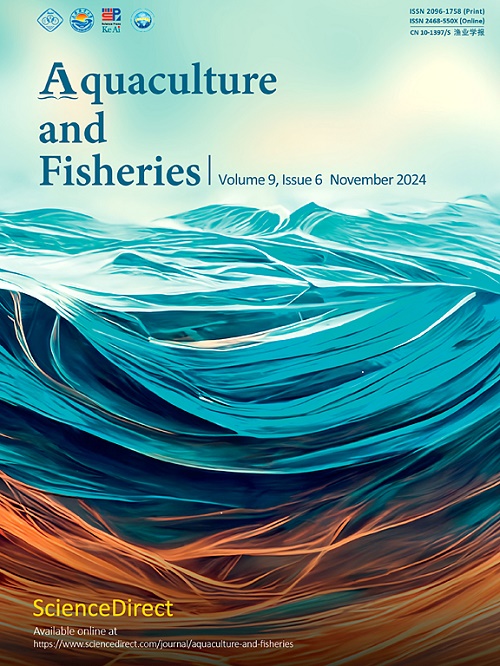中华绒螯蟹消化系统的组织学观察和基因表达
Q1 Agricultural and Biological Sciences
引用次数: 0
摘要
为了阐明中华绒螯蟹成虫消化系统组织的结构特征和基因表达,本研究采用组织学和转录组学技术对中华绒螯蟹消化系统进行了系统研究。结果表明,中华赤霉素消化系统主要由食道、胃(包括贲门胃和幽门胃)、中肠、肠球、后肠和肝胰腺组成。贲门胃不同部位的角质层钙化形成角质层小骨、几丁质牙、脊、刷毛等结构,共同构成研磨食物的“胃磨”。幽门胃含有特殊的梳状结构和成排的果胶状刚毛,它们是过滤和筛选食物的腺体过滤器的重要组成部分。中华鄂蚊消化道壁由粘膜层、粘膜下层、肌肉层和外膜四层组成,其中食管和后肠粘膜层表面有发育良好的角质层,有成排的刚毛,粘膜下层有特殊的粘液腺(食管腺或后肠腺);中肠粘膜表面无角质层,有致密的微绒毛。肠球具有中肠向后肠过渡的形态特征。肝胰腺由许多肝小管组成,肝小管中常见四种类型的细胞,包括吸收细胞(R细胞)、囊泡细胞(B细胞)、成纤维细胞(F细胞)和胚胎细胞(E细胞)。消化系统转录组数据显示,食道、胃、中肠、肠球、后肠和肝胰腺分别表达13252、13285、13634、11147、13127、12551个基因;分别表达1529、549、1199、624,990、1688个基因。从消化系统的6个组织中分离到25个消化酶基因。除麦芽糖苷酶-葡萄糖淀粉酶和磷酸酶A2在消化系统各组织中的表达差异不大外,其余消化酶在肝胰腺中的表达均最高。肝胰腺中高表达的消化酶有胰蛋白酶、胰肾素、羧肽酶B、α -淀粉酶和阿星酸。本文章由计算机程序翻译,如有差异,请以英文原文为准。
Histological observations and gene expression of the digestive system of the Chinses mitten crab (Eriocheir sinensis)
In order to elucidate the structural characteristics and gene expression of the tissues of the digestive system of adult Eriocheir sinensis, this study was conducted to systematically study the digestive system of E. sinensis using histological and transcriptomic techniques. The results showed that the digestive system of E. sinensis mainly consisted of the esophagus, stomach (including cardia stomach and pyloric stomach), midgut, intestinal bulb, hindgut and hepatopancreas. In the cardia stomach, calcification of the cuticle into cuticular ossicles, chitin tooth, ridge, bristles and other structures were observed at different sites, which together form the "Gastric mill" for grinding food. The pyloric stomach contains special comb-like structures and rows of pectinate bristles, which are important components of the gland filter for filtering and sifting food. The wall of the digestive tract of E. sinensis consists of four layers: the mucosal layer, the submucosal layer, the muscular layer and the outer membrane, of which the surface of the mucosal layer of the esophagus and hindgut has a well-developed cuticle with rows of setae, and the submucosal layer has special mucus glands (esophageal glands or hindgut glands); the surface of the mucosal layer of the midgut has no cuticle and has dense microvillus. The intestinal bulb has the morphological characteristics of the transition from midgut to hindgut. The hepatopancreas consists of many hepatic tubules, and four types of cells are often seen in the hepatic tubules, including absorptive cells (R cells), vesicular cells (B cells), fibroblasts (F cells), and embryonic cells (E cells). The transcriptome data of the digestive system of E. sinensis showed that Esophagus, Stomach, Midgut, Intestinal bulb, Hindgut and hepatopancreas expressed 13252, 13285, 13634, 11147, 13127, 12551 genes respectively; and they specifically expressed 1529, 549, 1199, 624,990, 1688 genes respectively. A total of 25 digestive enzyme genes were isolated from six tissues of the digestive system. Except for maltosidase-glucoamylase and phosphatase A2, which had small differences in expression in various tissues of the digestive system, all other digestive enzymes had the highest expression in the hepatopancreas. Digestive enzymes with high expression in the hepatopancreas are trypsin, pancreatic rennin, carboxypeptidase B, ɑ-amylase, and astacin.
求助全文
通过发布文献求助,成功后即可免费获取论文全文。
去求助
来源期刊

Aquaculture and Fisheries
Agricultural and Biological Sciences-Aquatic Science
CiteScore
7.50
自引率
0.00%
发文量
54
审稿时长
48 days
期刊介绍:
 求助内容:
求助内容: 应助结果提醒方式:
应助结果提醒方式:


